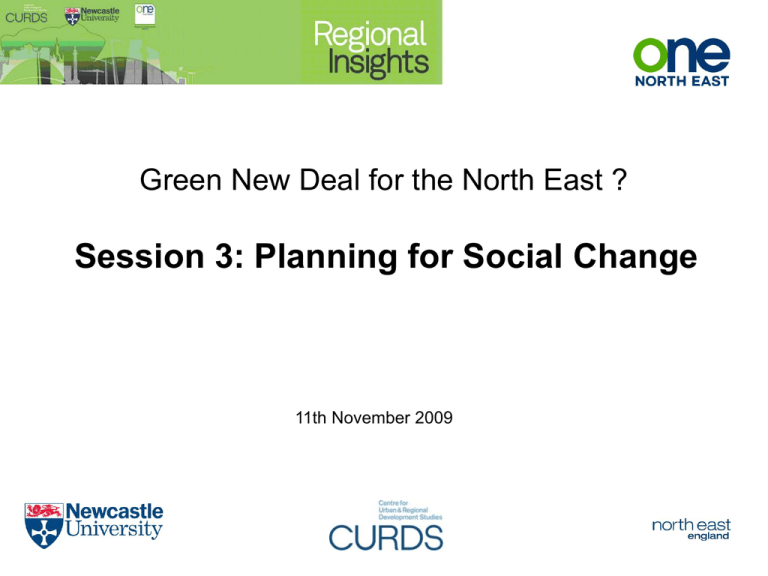
Green New Deal for the North East ?
Session 3: Planning for Social Change
11th November 2009
Towards the Low Carbon Economy in
the Tees Valley
John Lowther, Director of the Tees
Valley Joint Strategy Unit
Tees Valley Assets (1)
Tees Valley is the
- largest integrated chemical complex in the UK
- the third largest port in the UK
- the largest hydrogen network in the UK
- connected to a national pipeline network
- world-class engineering industry
- Centre for Process Innovation
- land/planning expertise for major developments
Tees Valley Assets (2)
Unique combination of infrastructure, skills, land, port and multi-national
companies.
World-class scale of the assets
- Ensus has built Europe’s largest bio-ethanol plant
- SABIC has built the world’s largest low density
polyethylene plant
- Biofuels Corporation biodiesel plant is of a world scale
- BOC Hydrogen plant is the UK’s largest
- Teesside Power Station is the world’s largest combined cycle
gas turbine power station
£4 billion pipeline of low carbon
investments
A £1 billion CCS network which would generate electricity from coal,
remove the CO2 and take CO2 from existing industrial plants, and
then store the CO2 under the North Sea
£300 million Northern Gateway Container Terminal, with deep water
jetties and import centres, will result in a net saving of up to 38.5
million tonnes of CO2 through reduction in road traffic from Southern
ports to the North of England
Collective investment of £1 billion on two combined heat and power
(CHP) plants
A £120 million expansion of the Energy from Waste plant including a
CHP
£4 billion pipeline of low carbon
investments (2)
Three new biomass power plants, one of which will be the UK’s second
largest, with an investment over £904 million
A £50 million autoclave facility generating high quality recyclate
A £80 million plant to recycle tyres, which would be the UK’s first full
scale commercial used tyre plant of its kind
A further £100 million biofuels plant
A £365 million paper recycling plant
These projects alone could create 2000 jobs, add £3.5 billion GVA to
the UK economy over the next 10 years, supply over 2200 MW of
secure low carbon electricity to the national grid, almost doubling the
amount of electricity currently installed in the North East, and re-use
waste
Challenge: How do we land the £4
billion pipeline of investment
North Tees/South Tees Study
- identify constraints on development e.g. infrastructure, land
ownership
- propose a land use framework
- identify other opportunities e.g. wind farm fabrication, hydrogen
economy
Challenge: How do we land the £4
billion pipeline of investment (2)
Problem
- Competitors are Port of Rotterdam, Port of Antwerp, Port
of Singapore – all purpose municipal development companies
- one stop shop
- Tees Valley is fragmented land ownership, no responsibility for
pipelines, infrastructure
- How can we deliver these projects in a partnership with the
private sector
3. Solution – A Task Force with Government
- a series of propositions
Proposition 1: A Carbon Capture and
Demonstrator
Tackling Storage
climate change
in Tees Valley…
Source: AEA, Carbon Trajectories Project
Carbon reduction targets means cutting Tees Valley C02 emissions to 20% of the
1990 level by 2050.
Proposition 1: A Carbon Capture and
Storage Demonstrator (2)
18 of 21 major CO2 emitters in the Tees Valley
Emissions Trading Scheme in 2013 a major threat to
energy intensive industry
Pilot CCS could give Tees Valley a major competitive
advantage safeguarding 12,000 jobs and reduce industrial
CO2 emissions by 49%
Proposition 2: Producing Green
Petrochemicals
Can we integrate proposals to ensure that we can produce syngas from
waste and biomass?
From syngas can produce:
- bionaptha for the SABIC cracker, reducing dependence on
oil/gas, and also price volatility of naptha
- green hydrogen, biokerosene for aircraft fuel
- Centre for Process Innovation at Wilton can help
develop these commercial technologies
Proposition 2: Producing Green
Petrochemicals (2)
Ineos – Bio feasibility study to convert biodegradable waste into road
transport fuel and clean electricity. £2.2 million from ONE/DECC
Government reviews it regulatory framework to facilitate rather than
prevent the use of waste and biological products in low carbon
industries
Proposition 3: Delivery of
Infrastructure
New Delivery Vehicles to:
Deal with connections to the national grid and local distribution
networks, working on a strategic plan for connections with the
national grid and NEDL, with technical support from DECC and the
Department of Business Innovation and Skills
Provide a robust integrated pipeline network to enable future
developments to take place
Make strategic land acquisitions where appropriate to safeguard
pipeline corridors or key strategic sites for future development
Proposition 3: Delivery of Infrastructure
(2)
Invest in an energy network that provides certainty of energy supply
and uses excess heat and steam for industrial use to help resist
global fluctuations in energy prices
Develop an energy supply company to use waste heat and steam to
provide energy for CHP schemes in residential areas
Proposition 4: Acceleration of Planned
Investments
Bringing forward the second nuclear power station for Hartlepool to the
2014 to 2019 period, thereby safeguarding the existing 700 jobs
when the existing power station closes – high national grid
connection user charges by OFGEM discriminate against a second
nuclear power station at Hartlepool in the short term
Enhancement of the rail gauge from Teesport to Hartlepool and the
East Coast Main Line to enable containers from the Northern
Gateway terminal to use the rail network, rather than the road
network
Proposition 5: Technical Experts Panel
A panel of technical experts from the Highways Agency,
Environment Agency, Natural England, NEDL, National
Grid and the Health and Safety Executive, working with
the local planning authorities to speed up the delivery of
projects of national importance and the infrastructure
connections.
Power Shift*
Can the public sector meet the carbon challenge?
November 2009
Dr Ruth Rule
pwc
*connectedthinking
PwC
Introduction
1. The Carbon Challenge
2. The Drivers
3. Intervention
4. Funding a Low Carbon Economy
PricewaterhouseCoopers LLP
November 2009
Slide 20
Power Shift*
The Carbon Challenge
UK Greenhouse Gas Emissions
•
•
•
•
The UK benefitted from the
switch from coal to gas in the
1980s and 90s.
Emissions reductions have now
tailed off in the UK.
Government has set aggressive
2020 targets for carbon
reduction.
New policy programmes and
regulations will apply to public
sector organisations
UK greenhouse gas emissions (mt CO2e)
900
800
Actual UK GHG
emissions to date
700
600
Interim 2020
target
500
Intended 2020 target
(applies if global deal
achieved)
400
300
200
Climate Change Act - 2050
target
100
0
1990
1993
1996
1999
2002
2005
2013
2020
2028
2035
2043
2050
Carbon energy will become a significant issue for Local Authorities over the next
5 years; action is needed now
PricewaterhouseCoopers LLP
November 2009
Slide 21
Power Shift*
Key drivers for carbon reduction
RELEVANCE
DRIVER
IMPACT
High
Carbon Reduction Commitment (CRC) Local Authorities currently spend in the region of
will start in April 2010.
£1.5 billion on energy per annum.
LAs must buy allowances in April 2011
w/o action, LA energy costs are projected to
increase by 2-3% by 2011 and ~25% by 2014 as
a result of the CRC.
High
Carbon Budgets: Government to give
each Department responsibility for
achieving a Carbon Budget.
TBD but financial penalties may be imposed by
Departments (eg CLG, Defra etc) on LAs who fail
to meet applicable reduction targets
Medium
EU Emissions Trading Scheme:
permits will be auctioned for electricity
generators from 2012.
Increased generation costs.
Medium
Energy prices. As the world economy
emerges from recession, energy
resource constraints are expected to reemerge pushing up oil/gas prices.
Increased price volatility expected in next 5 years.
Price trend is upward.
Low
EU Renewable Energy Directive. UK
must achieve 15% renewable energy
target by 2020
Transition to renewable energy will lead to
increases in power prices reflecting investment
required and LRMC of new technologies.
November 2009
PricewaterhouseCoopers LLP
Slide 22
Power Shift*
Intervention
What can the public sector do to improve services and meet local policy objectives under this cost
pressure?
Additional Drivers
Government
Regulation
Carbon Reduction Commitment
Strategy
Compliance
Develop a strategic approach
and optimise performance in
relation to CRC
Plan and implement actions
to achieve compliance with
CRC
Assurance
Assurance
Undertake
Assurance
assurance
/ internal
/
internal
verification
verification
ofon
CRC
CRC
submission
submission
Carbon Budgets
Community Energy
Saving Programme
Carbon Budgeting
Low Carbon Economy
Decent Homes
Options Development
Carbon Emissions
Reduction Targets
Cost Review
Options Analysis
Value at Risk
Review of carbon and energy
cost (either stand alone or
integrated into full cost review)
Options analysis to
determine best available
solution
Assess the carbon and energy
“value at risk” in a public sector
organisation
Feed in Tariffs
Zero carbon Homes
Warm Front & fuel
poverty
Intervention
Investment
Opportunities
Renewable Heat
Initiative
Smart Metering
Efficiency
Infrastructure
Procurement
Implement energy and carbon
cost reduction programme
(either stand alone or
integrated)
Develop decentralised
energy systems or renewable
energy
Change asset procurement
process to ensure full energy
and carbon costs are
considered.
PricewaterhouseCoopers LLP
November 2009
Slide 23
Power Shift*
Key actions for Local Authorities
DRIVER
IMPACT
CRC Obligations
Local Authorities can benefit from achieving “best in class” performance
through bonus payments. Poor performance may result in penalties. Planning
for the CRC needs to start now in advance of the April 2010 start date.
Alternative &
decentralised energy
HMG is promoting wider use of decentralised energy, district heating and CHP
with a Renewable Heat Incentive scheme to be introduced from 2011. Local
Authorities have a key role to play in implementing this policy.
Opportunities also exist to develop renewable energy schemes either in
association with district heating schemes or on a stand alone basis (eg on old
landfill sites).
Housing & public
buildings
New regulations will come into force from 2013 onwards, with all new homes
[& schools] “zero carbon” from 2016; other non-domestic buildings zero
carbon by 2018/19 (tbc). Without access to low carbon energy these targets
will be unaffordable. A new “feed in tariff” scheme, to be introduced in 2010,
will encourage dispersed micro-generation. Local Authorities have a key role
to play in facilitating investment in low carbon improvements.
Procurement
Local Authorities will need to reflect low carbon objectives in their procurement
procedures. CRC obligations will impact on existing contracts including PFIs.
New contracts should take account of new regulations now.
PricewaterhouseCoopers LLP
November 2009
Slide 24
Power Shift*
Funding a Low Carbon Economy
Is it possible for the public sector to make a step change in funding sustainable
projects that often cannot be financed through traditional sources?
Current barriers to funding a low carbon economy include:
•
•
•
•
Different technologies, thus requiring new risk management approaches and new forms
of capital
Financing structure and scale, low carbon capital projects often carry higher upfront
costs and lower operational costs, their requirement for external financing is high and
due to scale (e.g. CHP) the transaction costs can be disproportionately high
Limited track record
Private sector investment not focused on decentralised energy/retrofit to reduce carbon
outputs at the local level
How can the public sector in the region take the initiative to kick off
investment in the North East aimed at financing the transformation to a
low carbon economy?
PricewaterhouseCoopers LLP
November 2009
Slide 25
Power Shift*
A Case Study – Toronto Atmospheric Fund
Toronto Atmospheric Fund finances initiatives in the city region that combat global
climate change and improve air quality through a self-sustaining revolving fund
Since its inception TAF has reduced CO2 emissions by 500,000 tons, its
successes include:
•
•
•
•
Canada’s first municipal combined heat, power, and cooling system (tri-generation);
its largest solar power plant;
an energy efficiency financing program that targets new condominium construction;
and a pilot test of outdoor LED white lighting.
TAF fund now $30m provides grants, makes loans, invests in projects, and
creates partnerships with all sectors of the community, city departments and
agencies to facilitate action on climate change.
PricewaterhouseCoopers LLP
November 2009
Slide 26
Power Shift*
A Green Fund for the North East?
The revolving fund model is a one that could be adapted to the regions circumstances
European Funds,
e.g. JESSICA
Accelerating
Capital
DEBT / EQUITY
(Matched Funding)
SEED FUNDING
DEBT / EQUITY
GRANT /EQUITY /DEBT
Revolving Fund
ROI
ROI
SPV
ROI
DEBT / EQUITY ROI
GRANT / LOAN
Investment
ROI/ SAVINGS
Investment
•
Investment yields energy cost savings or revenue
•
Savings or revenue pay back financing
•
Net savings or revenue placed in revolving fund
•
New projects financed from revolving fund
PricewaterhouseCoopers LLP
ROI
GRANT /EQUITY /DEBT
Holding Fund
EQUITY / DEBT
Private
Finance
Investment
November 2009
Slide 27
Power Shift*
A Green Energy Fund for the North East?
Could a green energy fund similar to TAF, Woking and the proposed Energy
for London Fund be created?
•
Entities that are dedicated to climate mitigation can focus leadership, develop integrated
strategies, and multiply resources in a way that is often challenging to accomplish in a
diverse number of smaller organisations;
•
Energy efficiency investments create revenue streams that can both service capital
financing for projects as well as provide income for incubating new projects;
•
The greater proportion of savings that can be recycled into new projects, the greater the
acceleration of emissions reductions and the more rapid the expansion of capital available
for climate mitigation over time;
•
Revolving funds operate best as public private partnerships in order to be able to make
strategic decisions and maintain their capital base in difficult budget times;
•
Incubation funding to “get the ball rolling” and project financing to scale up pilots are
strategies that go hand in hand and could be used in the North East to create a low
carbon economy
PricewaterhouseCoopers LLP
November 2009
Slide 28
This publication has been prepared for general guidance on matters of interest only, and does not constitute
professional advice. You should not act upon the information contained in this publication without obtaining specific
professional advice. No representation or warranty (express or implied) is given as to the accuracy or completeness
of the information contained in this publication, and, to the extent permitted by law, PricewaterhouseCoopers LLP,
its members, employees and agents do not accept or assume any liability, responsibility or duty of care for any
consequences of you or anyone else acting, or refraining to act, in reliance on the information contained in this
publication or for any decision based on it.
© 2009 PricewaterhouseCoopers LLP. All rights reserved. 'PricewaterhouseCoopers' refers to
PricewaterhouseCoopers LLP (a limited liability partnership in the United Kingdom) or, as the context requires, the
PricewaterhouseCoopers global network or other member firms of the network, each of which is a separate and
independent legal entity.
PricewaterhouseCoopers LLP
PwC
Green New Deal for the North East ?
Panel Discussion
Chair: Professor John Tomaney, CURDS
Sarah Green, CBI
Professor Dermot Roddy, Sir Joseph Swan Institute
Kevin Rowan, Northern TUC





